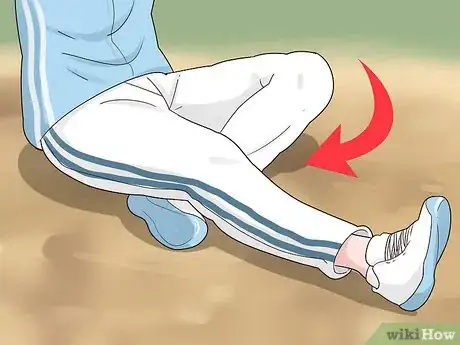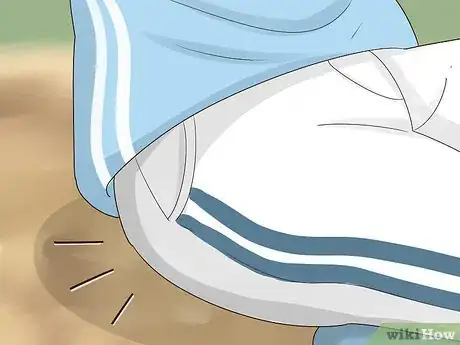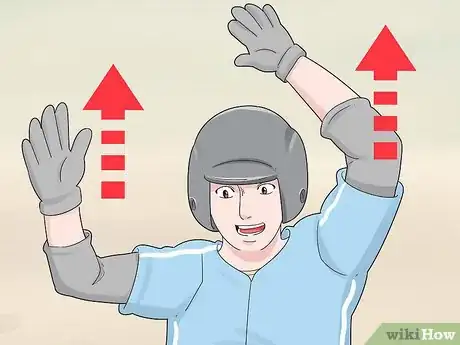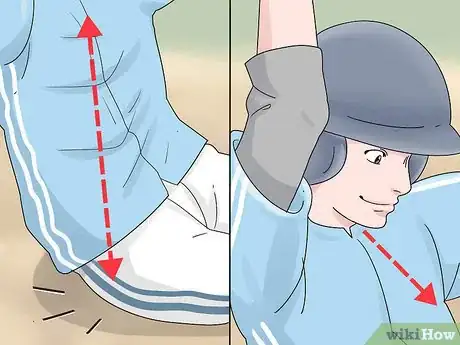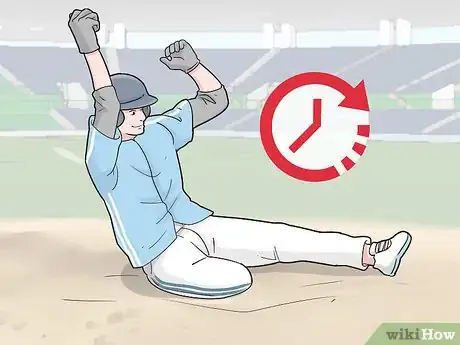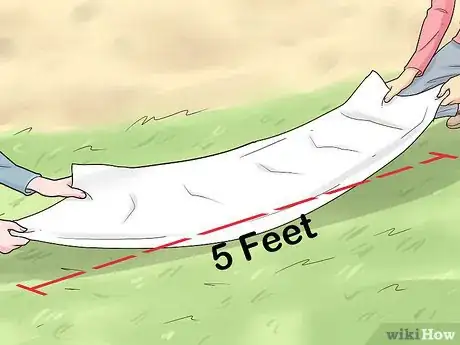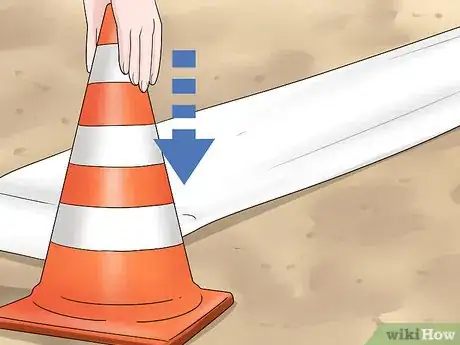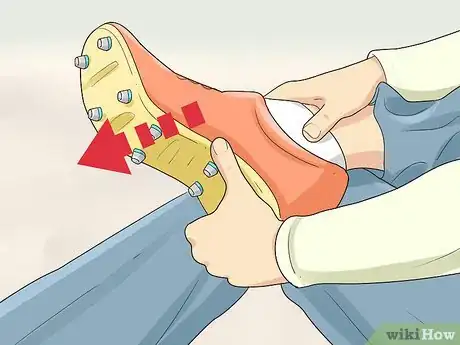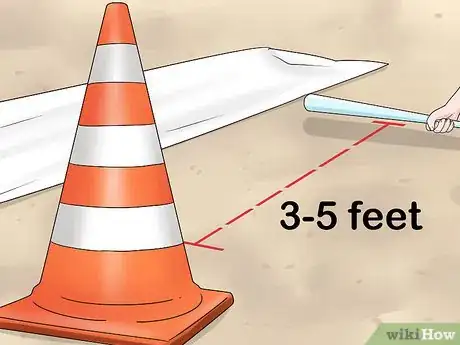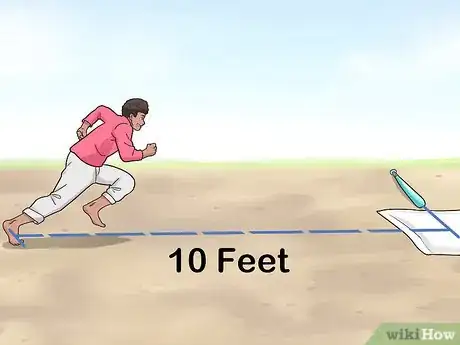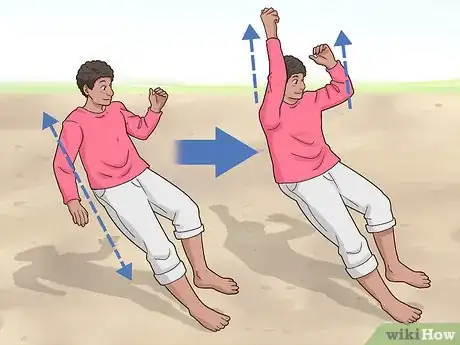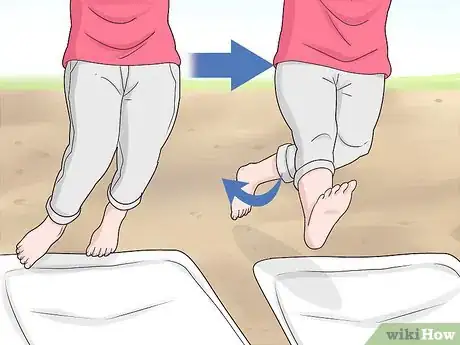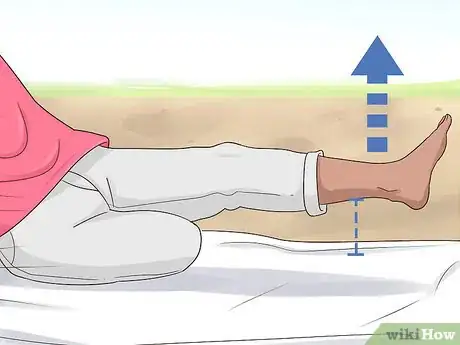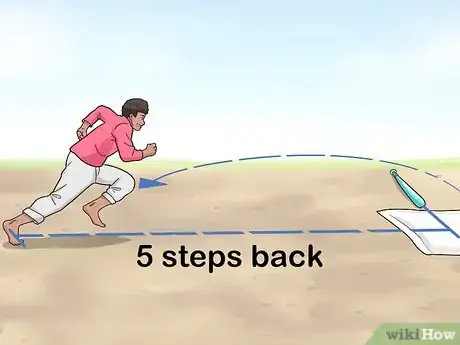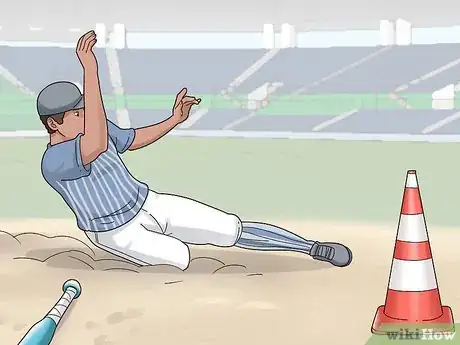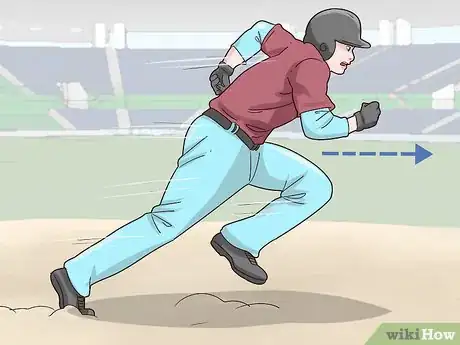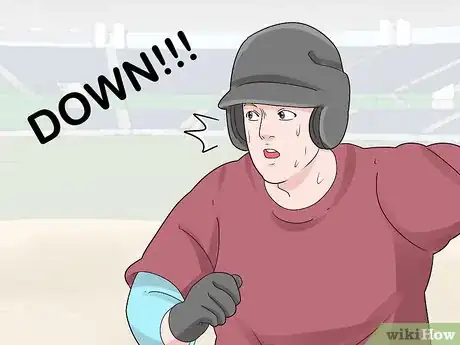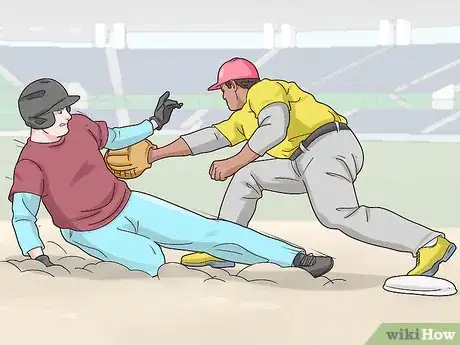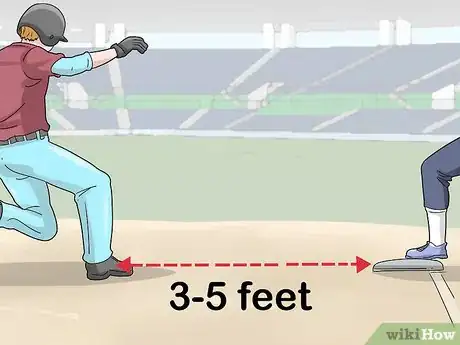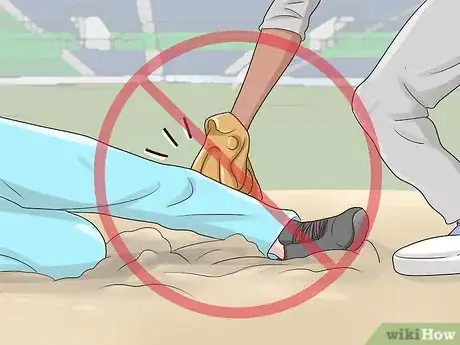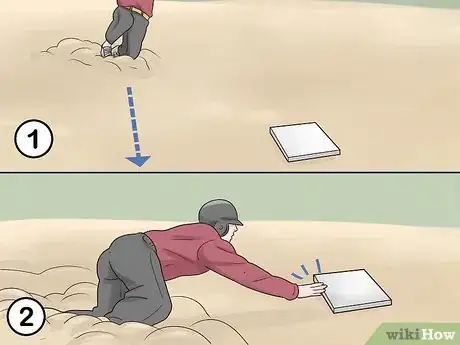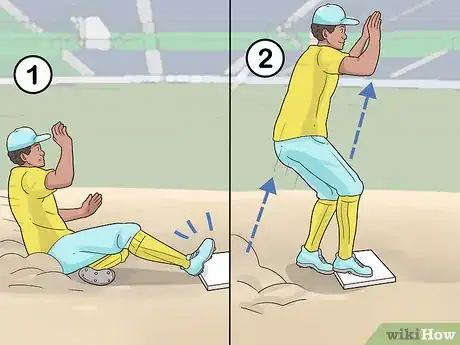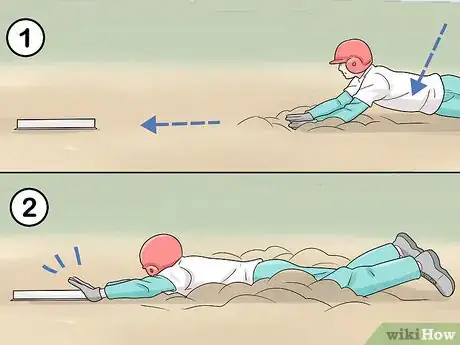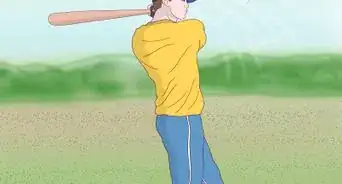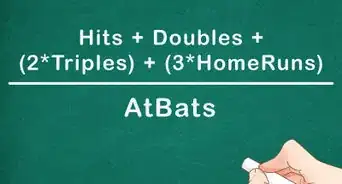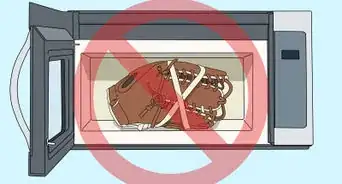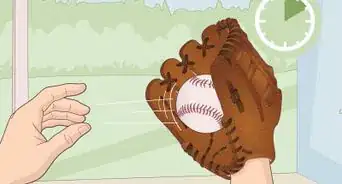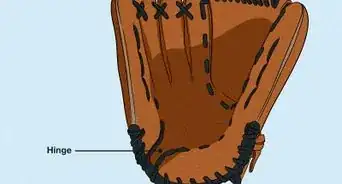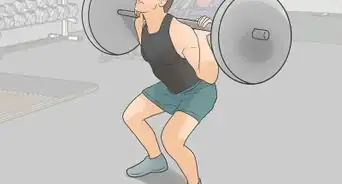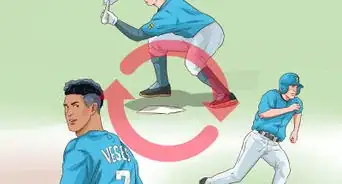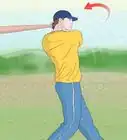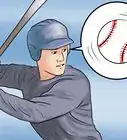This article was co-authored by Isaac Hess. Isaac Hess is a Baseball Coach, Instructor, and the Founder of MADE Baseball Development and Champion Mindset Training Program, a baseball training program based in Los Angeles, California. Isaac has over 14 years of experience coaching baseball and specializes in private lessons and tournaments. He has played baseball for both professional and collegiate leagues including Washington State University and the University of Arizona. Isaac was ranked as one of Baseball America's top 10 prospects for 2007 and 2008. He earned a BS in Regional Development from the University of Arizona in 2007.
There are 11 references cited in this article, which can be found at the bottom of the page.
This article has been viewed 94,628 times.
When it’s the bottom of the ninth and you’re down by three runs, a well-executed slide into home plate could mean the difference between winning and losing. With good form and a little bit of practice, you’ll be able to slide comfortably and safely--and hopefully you’ll come in safe, too!
Steps
Bent-Leg Slide
-
1Sit on the ground and make a figure-4 with your legs. Sit with your legs straight out in front of you. Fold one leg under the opposite knee, so you’re forming a figure-4 with your legs. Keep the toes of your forward foot pointing upwards. To choose which leg to bend, try both out and see which one feels most comfortable to you.[1]
- Most right-handed players find it more comfortable to keep their right leg straight during a slide, while many lefties like to stretch out their left leg. Choose whichever feels the best for you!
-
2Keep your weight centered on your butt to avoid scraping your side. It’s easy and sometimes even comfortable to tilt to the side when you slide, but you’ll end up with bruises and scrapes on your legs and sides, or even bigger injuries. Instead, sit flat on your butt. That’s where your body has the most cushioning, so it’s the safest--and least painful!--way to slide.[2]Advertisement
-
3Put your hands in the air so you don’t jam your wrists. Keep your arms slightly bent and throw your hands just above your head. This will help you avoid dragging your hands on the ground, which can scrape up your palms or even cause a wrist or finger injury if you hit the ground hard.[3]
- When you start practicing your slides, you’ll also see that throwing your hands up will help you keep your balance.
-
4Keep your core tight and tuck your chin into your chest. A tight core will help you keep your balance, and tucking your chin to your chest will prevent you from throwing your head back and hitting it against the ground. You can lean back just slightly--when you slide, your momentum will probably force you to anyways-- but don’t throw back your chest.[4]
-
5Sit in this position for a few minutes and get comfortable in it. You’re sitting in a perfect bent-leg sliding position: one leg bent under the other, weight centered and leaning back, and your hands in the air. Notice what it feels like and let your body get comfortable. You’re training your muscles to remember what this feels like so you can feel confident when you start to practice sliding at speed.
Practicing on a Mat
-
1Set up a piece of cardboard or a slip’n’slide in the grass. When you’re learning to slide, it’s best to practice on a smooth, soft surface before moving on to the dirt. Lay a flat piece of cardboard on grass, at least 5 feet (1.5 m) long. For a really fun sliding practice, set up a slip’n’slide in the grass. The soft plastic and the water will make it easy and fun to practice your slides, as long as you don’t mind getting soaked!
- To use a piece of cardboard without it sliding around, have 2 people hold down the front 2 corners. They can stand one foot on the corners and step back with the other foot so you don’t run into them.
- If you don’t mind spending a bit more money, you can also buy a sliding mat online or at a sports or baseball retailer.
- If you’re on grass that’s soft without many weeds or plants, you can also simply slide straight onto the grass without a covering. You might get grass burns or stains on your clothes, though, so use cardboard if you have it.
-
2Place a cone or thin, plastic base on the mat to act as the “base.” Set down a visible marker for the base near the end of the cardboard or slip’n’slide. This will be the base that you’ll be aiming for. You’re still working out the timing and coordination of your slide, so it’s best to use a soft object, instead of the hard base you use on the field, to avoid getting injured.[5]
- If you’re on a mat, cardboard, or grass, you can also set down a glove as your base. Don’t use a glove if you’re sliding on a slip’n’slide, though, because it will soak the leather.
-
3Take off your shoes to avoid catching your cleats on the cardboard. Sliding in your socks is the easiest way to slide, because you don’t have to worry about your shoes tripping you up on the cardboard or grass. You’ll also be able to see and feel how your feet are moving, making t easier to make quick adjustments.[6]
-
4Set a marker 3 to 5 feet (0.91 to 1.52 m) away from the base as a slide-starting mark. Set it slightly off to the side so you don’t hit it when you start sliding. This marker will tell you when you should start lowering into your slide.[7]
- If you can’t measure the distance exactly, take 3-5 big steps away from the base and put the marker there.
-
5Jog to the base from 10 feet (3.0 m) away, starting to slide at the mark. Back up about 10 feet (3.0 m) from the base and run towards it at about ¾ of your normal speed. You need enough speed to gather momentum for the slide, but you don’t have to go full speed just yet if you’re nervous. Keep your eyes on the base, but track the sliding cone out of the corner of your eye. When you get level with it, you know it’s time to start sliding.
-
6Lean back slightly and throw your hands up. Before you start bending your leg, lean back just a little to lower your center of gravity. Lift your hands just slightly so you don’t drag them on the ground. Focus on just starting to lower yourself to the ground in a smooth motion, while still moving forward.
- If you have trouble remembering to keep your hands up, have a friend, parent, or coach toss you a ball as you go into your slide. Trying to catch the ball as you’re sliding will force you to keep your hands in the air.
-
7Push off with your back foot, then bend it behind your other knee. Take one last explosive step with your back foot. This will be your bent foot, so if you’re a natural right-hander, it will likely be your left foot; if you’re a leftie, it’ll probably be your right. Right after you push off, tuck your foot under your straight leg.[8]
- Try not to jump up and into the slide, even though it might feel more natural. The higher you push off into your slide, the harder you’ll hit the ground and the more painful it’ll be!
- Think of this big step as a forward push off of your back foot, instead of a jump into the air.
- Don’t fold your knee straight back underneath your body. This will place a dangerous amount of strain on the joint.
-
8Aim your lead foot at the mark, keeping it slightly off the ground. As you lower into your slide, keep your body facing forward so that you’ll land on your butt instead of your side. Point your lead foot towards to base, keeping it a few inches in the air. When you slide into a real base, this will help you avoid jamming your foot into the base and getting hurt.[9]
- Your slide will happen very quickly, so don’t try and think about everything all at once. Focus on one thing at a time: run, throw your hands up, bend your leg, lower down to your butt, aim for the base. It may seem like a lot to remember now, but with lots of practice it’ll feel like second nature to you.
-
9Return to the start, backing up and increasing your speed. Jog back out to where you started, then take about 5 steps back. Now try running a little faster towards the base. Continue backing up and increasing your speed until you’re about as far away as the distance between 2 bases on a field and running at a full sprint.
- Practice with a coach to stay safe. A coach can also give you tips and tell you what you need to improve on.
-
10Practice sliding on the dirt once you’ve got the form down. The dirt will be harder and less smooth than the cardboard, mat, or grass, so it’s important to keep your form the same. Focus on landing on your butt so you don’t scrape yourself up, and remember to keep your hands in the air. You also might have to adjust the timing of your slide, depending on how soft or hard the infield is.
- Give yourself some extra room on the first run, then adjust the start of your slide if you need to.
Sliding During Games
-
1Run full-speed towards the base. Keep your steps smooth and steady, with your body leaning forward slightly. You have to keep your speed up so you can keep moving forward once you hit the ground. Unless you’re moving at a good speed, you won’t go anywhere when you hit the ground.
- Your momentum will be transferred into the slide, carrying you to the plate swiftly and without wasted movement.
-
2Look and listen for sliding signals from your third base coach. When you’re running the bases, your third base coach has the best view of the field. They’ll be yelling to you to keep running or stop at a base, and whether you need to slide or not. If you hear them yelling “Down” or “Slide,” you’ll know that a throw is coming to your base and that you need to slide to avoid the tag.
- More advanced players might be able to take a look over their shoulder to locate the ball and determine whether they need to slide or not. This can be hard to do and will slow you down, though, so it’s best to look at and listen to your coach until you get more comfortable on the basepaths.
- You can also decide to slide based on the game situation. For example, if you’re on first and a grounder is hit in the infield, you’ll want to slide going into second to try to break up the double play.
- You can also slide if you’re running fast and don’t want to overrun the bag on accident, or need to avoid contact with another player.
-
3Aim away from the opposing player, if possible. In a sliding situation, an opposing player will often be on the base waiting for the ball to tag you out. If they’re waiting on one side of the base, try sliding to the front of the base or on the other side. If they’re standing directly in front of the base, aim your slide to the side. Deciding where on the base to slide can help you avoid the tag and come in safe.
-
4Begin your slide 3 to 5 feet (0.91 to 1.52 m) away from the base. Begin to lower your body, bending one leg and aiming the other towards the bag. Remember how much you’ve practiced sliding and let your instincts take over. Keep your hands and front foot in the air to prevent injury.
-
5Avoid the tag if you can, but stay focused on your sliding form. As you slide, the other player will be trying to tag you, swiping down with their glove or moving their body so that you can’t get to the base. You can try moving your legs slightly to avoid a tag, but the most important thing is to keep your form together so that you don’t hurt yourself.
- Try not to lean your whole body away from the tag. You’ll probably scrape yourself up and you might even lean too far and roll away from the bag, making it easy for the player to tag you out.
Specialty Slides
-
1Try the hook slide to avoid a tag. The hook slide, also called the backdoor slide, is essentially the same as the bent-leg slide--the only thing you’ll be changing is where you aim your body. You’ll start your slide slightly later and aim past the bag, not straight at it. Slide past the base and grab it with your hand as you go by.
- This slide is great to use if you see that the player already has the ball and is ready to tag you out. Instead of sliding straight into them, using a hook slide gives you a greater chance of avoiding the tag and being safe.
-
2Use a pop-up slide to quickly get back on your feet. To do a pop-up slide, start your slide a bit later. As soon as your front foot hits the base, plant your front cleat on the bag and use your momentum to push up off of the calf of your bent leg. If you have extra momentum, quickly shuffle your feet across the base, switching the foot that’s touching the bag.
- Don’t use your hands to push yourself up. You should be able to pop up using the strength of your legs and your momentum alone.
- Use this slide if you’ve already committed to a slide but you can see that you’ll definitely be safe--if the ball is overthrown, for example. By popping up quickly, you might be able to take an extra base.
-
3Learn the headfirst slide once you’re more experienced. This slide is faster than the bent-leg because it works with your natural momentum.[10] However, it’s also more dangerous than the bent-leg, with the risk of jamming your fingers or knocking your head if you don’t have the correct form. To do a headfirst slide, run full speed, then lean forward and dive horizontally, landing on the heels of your hands and your chest. Keep your palms down but your fingers off the ground to avoid crushing them into the base. Dig the toes of your shoes into the dirt if you need to stop the slide.
- Only use this slide if your coach teaches it and advises you to use it. The headfirst slide isn’t allowed in Little League for players under 13, unless you’re going back to a base, on a pick-off play or a caught fly ball, for example. From age 13 and up, you can slide headfirst while advancing to a base, as long as your coach allows it.[11]
- It’s also helpful to know the headfirst slide for defensive plays. The technique is basically the same if you’re diving for a ball in the field.
Community Q&A
-
QuestionHow do I throw a baseball hard?
 DonaganTop AnswererThis is mainly a function of strength. You'll throw harder as you get bigger. However, your throwing technique also plays a role. You should literally allow your whole body to "fall" toward your target, letting gravity pull your upper body toward the ground as if you were "tipping over." This adds momentum to your throwing arm. Twisting your hips as you throw also adds to the power of your throw. Finally, "follow through." Continue your throwing motion after you've let go of the ball. That means finishing the arc your hand makes as you throw until your hand is pointing toward the ground. This relieves a little of the strain on your arm.
DonaganTop AnswererThis is mainly a function of strength. You'll throw harder as you get bigger. However, your throwing technique also plays a role. You should literally allow your whole body to "fall" toward your target, letting gravity pull your upper body toward the ground as if you were "tipping over." This adds momentum to your throwing arm. Twisting your hips as you throw also adds to the power of your throw. Finally, "follow through." Continue your throwing motion after you've let go of the ball. That means finishing the arc your hand makes as you throw until your hand is pointing toward the ground. This relieves a little of the strain on your arm. -
QuestionHow far from the bag should I start a head first slide?
 Community AnswerFor the most part you shouldn’t be doing head first slides (unless on a pick-off). The reason you shouldn’t really do it is because there are a lot of potential finger injuries. About 8 feet away is when you should start extending your arms out and executing the slide.
Community AnswerFor the most part you shouldn’t be doing head first slides (unless on a pick-off). The reason you shouldn’t really do it is because there are a lot of potential finger injuries. About 8 feet away is when you should start extending your arms out and executing the slide. -
QuestionHow do I dive into the base?
 Community AnswerKeep your arms extended so that you sort of land on your arms before your hands hit the ground. If your hands hit the ground first, they might stop the slide and make you go face first into the dirt.
Community AnswerKeep your arms extended so that you sort of land on your arms before your hands hit the ground. If your hands hit the ground first, they might stop the slide and make you go face first into the dirt.
Warnings
- Sliding is a technique that should be in every baseball player’s repertoire, but it’s one that can lead to injury if not pulled off correctly. When you’re learning how to slide, always make sure a coach or parent is there to watch and help you if you get hurt.⧼thumbs_response⧽
References
- ↑ https://www.youtube.com/watch?v=_IqNFzu34b4&feature=youtu.be&t=2m58s
- ↑ https://www.youtube.com/watch?v=_IqNFzu34b4&feature=youtu.be&t=3m14s
- ↑ https://www.youtube.com/watch?v=_IqNFzu34b4&feature=youtu.be&t=3m33s
- ↑ https://www.youtube.com/watch?v=8BIbkFkhAMA&feature=youtu.be&t=1m12s
- ↑ https://www.youtube.com/watch?v=_IqNFzu34b4&feature=youtu.be&t=48s
- ↑ https://www.youtube.com/watch?v=_IqNFzu34b4&feature=youtu.be&t=4m42s
- ↑ https://www.youtube.com/watch?v=8BIbkFkhAMA&feature=youtu.be&t=1m32s
- ↑ https://www.youtube.com/watch?v=8BIbkFkhAMA&feature=youtu.be&t=2m
- ↑ https://www.youtube.com/watch?v=8BIbkFkhAMA&feature=youtu.be&t=1m1s
- ↑ Isaac Hess. Baseball Coach & Instructor. Expert Interview. 20 March 2020.
- ↑ https://www.littleleague.org/university/articles/backyard-tips-sliding-tip/
About This Article
To learn a classic bent-leg slide, set a long, flat piece of cardboard on soft grass. Back up 10 feet and run towards it, lowering your body when you get 3 to 5 feet away. Bend one leg under the opposite knee, raise your hands above your head, and land on your butt. Keep your body slightly leaned back and your chin tucked into your chest. To work up to sliding on dirt and in games, and to learn specialty moves like the pop-up slide, read on!
